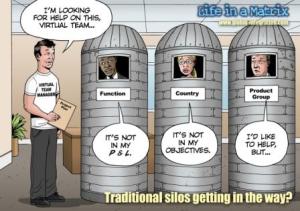This is the forth in a leadership series that looks how to implement successful change that fulfills people and avoids human casualties.
Our question is, how do we create working relationships that are rewarding? (Rewarding not just productive). Why? It’s only by energizing people and harnessing technologies better than anyone else that companies can thrive. Genuinely aligned, empowered and collaborative people will outperform the competition every time.
In this blog, I consider probably one of the most difficult areas is sales, especially complex sales.
What makes sales complex?
Classically, “Many to Many” Think of it like a bow tie. On the left side you have the selling organization and on the right Complex Sales. Typical characteristics:
- Many decision makers
- Team selling
- Proposal or tender based selling (RFP)
- Post sales support requirements like after sales service
- Needs tailored solutions
- High value, e.g often needing board approval
- Long sales cycles
- Technical/knowledge based elements
- Consultative selling requirements
- Customer relationship focus
So, more people across the company need to communicate with customers and prospects before, during and after the sale. This increases complexity and the difficulty of “Keeping Everyone On The Same Page”
Why are sales getting more complex?
Business is more turbulent changing and morphing. It places, the sales function at the fulcrum of value creation and innovation within the firm.
For example, the exponentially increasing information that sales people are expected to know about their company’s offerings, all the associated resources, processes and ‘best practices’ associated with each offering. And especially important, how each can benefit their prospect or customer
This challenge of increasing complexity is not unique to sales. But, as salespeople serve as an interface between their company and customers, they are particularly affected by rapid internal and external changes
How does this affect sales people?
For account managers complexity builds stress, frustration and dissatisfaction. This is especially true in deciding the “right” goal and priorities.
Both account and sales management need new coping strategies. Like many functions:
“Managing complexity is not a sales person problem, but rather a company problem — one which requires an integrated effort of sales, marketing, and solutions experts to successfully solve.”
(Scott Santucci, Senior Analyst, Forrester Research)
What are the key issues and trends in this situation?
An Ashridge Consulting survey of Sales Directors and C-Level executives identified the following challenges:
Competitive Challenges
- Speed of product and service innovation
- Channel diversification
- Consolidating market places
Organizational Challenges:
However their greatest challenges related to:
- Internal decision making processes
- Developing effective matrix organization structures
- Market intelligence
- Sales support functions
- E-business capability
- Managing global delivery systems.
Roles, competencies and retention of sales staff:
Not surprisingly respondents also considered roles, competencies and approaches to retention as requiring considerable change in the near future. In particular respondents felt that integrating sales teams with other customer facing staff is a key challenge.
Can you give an example of where these trends are seen?
Take IT & Communications. The sale is no longer simply a product sale. Customers seek innovative solutions to complex, often ill specified needs. The skill required to engage with these are very different from the traditional skills expected of “IT box” sellers. Similarly the sales process is increasingly highly technical spanning many specialist technologies. This is driven by customer’s needs for solutions that contribute toward their business goals. In such situations sales professionals need competencies in account and relationship management as well as project team management competence to achieve the sale. Then, they have to oversee a complex implementation, and then provide service and solution up-grades throughout the life of the relationship. These companies are changing internal structures and processes to provide this relationship management, customer service and support.
How does this apply to other sectors?
Across many sectors some patterns in Complex Selling have emerged:
- Focusing on relationship management
- Using supporting technology
- Expanding Account Management positions
The sales process is growing in complexity and difficulty. The challenge is to strengthen existing customer relationships by working harder to understand their future needs and services.
The greatest changes required relate to internal decision making processes and the development of effective matrix organizations. This is driven by more complex realities for which Sales needs better organization, increasingly less hierarchical and more matrix oriented. They have to improve the alignment between sales and other functions that touch customers. Increasingly cross-functional ownership of the customer is the operating reality.
What is a matrix organization?
 Many see the matrix resolving the classic problems of centralizing or decentralizing resources for best results. However, matrix organizations needs different ways leading and managing for which many companies simply do not lay the necessary groundwork to ensure success matrix.
Many see the matrix resolving the classic problems of centralizing or decentralizing resources for best results. However, matrix organizations needs different ways leading and managing for which many companies simply do not lay the necessary groundwork to ensure success matrix.
Company after company have started and abandoned the matrix organization over the years. Yet, today the matrix is alive and well. Why? Perhaps there is no bigger driver for the matrix’s re-emergence than increasing use of teams – virtual, project, and cross-functional – to improve speed of delivery, customer responsiveness, cost control and productivity.
A dramatic example of this is Cisco, which announced recently a different kind of re-organization. CEO, John Chambers, wants to see the company move into more than two dozen new businesses, from consumer camcorders to giant TV screens for stadiums.
The impetus for these kinds of teams are so pervasive in companies today is similar to what drove many to create the matrix form in the first place a business need to be:
- More nimble
- Move quickly
- Get people with different disciplines to work effectively
- Get around the issues of hierarchy.
However, many of the issues faced by early adopters that started and abandoned the matrix form are still relevant and need to be addressed today.
A foundational element in matrix companies and teams today is that of trust. As Steven Covey pointed out, trust is central to many Companies today. Building trust is the oil that makes this form of organization run smoothly and be successful. So, a careful investment of time and effort early-on to build this trust will pay significant dividends. Such efforts center on re-aligning and aligning people to get the on the “Matrix Page”.
What are the lessons learnt about making matrix management work? Four things stand out:
- Define roles and responsibilities up front. In a matrix, there are at least two sets of roles that are important to define: the matrix leader who is reporting to at least two bosses (one is the functional boss – the boss to whom he/she ordinarily reports to, and the other is the matrix boss),
- Who is responsible? Who is accountable? Who should be consulted? Who will implement?
- Agree on performance goals and metrics when the team is first formed. Establish ground rules or operating agreements on resource allocation and communication.
- 4. Determine how evaluations and rewards are going to be decided. Who will evaluate the performance of the team and the leader, and how will rewards be decided?
What other areas do you see as a priority for sales organizations?
Survey respondents’ top issues were:
- Retention of top performers
- Current role of sales professionals in the business
- Managing the expectations of sales professionals
- Managing the expectations of sales work/life balance
In particular integrating sales with other customer facing staff is a key requirement. It reflects the increased recognition for
- Increasingly CRM-oriented approach
- Increased team working
- Competitive differentiation
- Integrating and enabling technologies
- Different skills and behaviors of all parties.
Clearly, gone are the days when sales people were seen as (and at times encouraged to be) “solo-flying heroes”. Roles are changing dramatically and that retention of top performers is critical. Now, effective sales people need very different competencies which are not easily identified or developed. It requires sophisticated coordinators which mean they must behave in different ways and add value.
As two respondents commented:
“We are struggling with roles – pure relationship, consulting skills, and solution skills – how to become an effective matrix”
“The changes ahead will bring significant required changes with regard to roles and competencies of the sales people.”
What about the future? – What will help? And what will hinder?
What will help? |
What will hinder? |
|
|
|
|
|
|
|
|
| · Building a “Can Win” Culture |
|
|
Sales professionals see customer demands escalating, internal processes changing and their own roles being transformed. For many this has enriched their jobs yet, they still have critical shortfalls in role definition, team integration, recruitment and competency development. The sales person’s job is thus not simply to “win orders”, it is to “build and sustain business”.
Yet, companies continue to be challenged by difficulties of making complex matrix structures work effectively. They struggle with the skills needed to operate the many communications channels across functions. This is strained by the continual need to improve and integrate customer service.
“Sales” has yet to meet this challenge. Organisational, role definition, recruitment, retention and competence development. While some are addressing these issues many are not… However, compared to other functional and professional business areas (Finance, Supply, Manufacturing, Marketing) the sales area has been less rigorous in assessing organisational and personal capabilities and slower to address these issues.
It is evident that many companies, having fulfilled the basics, now need to consider how they create new customer and account management Companies that are competent, integrated and effective
Given the changes in customers’ demands, buying processes and technologies, sales companies need to pay particular attention to:
- How they draw upon a wider and less traditional range of skills and expertise
- How they change and support current ways of working,
- How they network within / outside their more complex customers to develop strong and valuable customer relationships.
Against this background of needs and challenges – the recruitment, deployment and development of sales people in new and different ways is self evidently a strategic imperative.
Four Questions on Moving Forward:
- What new competencies will sales people need in the future?
- How will sales Companies manage the change process from where they are now to the desired state?
- What communication and involvement is required to keep valuable staff motivated during the change process?
- What expertise do sales Companies require to enable them to do this work?
__________________________________________________________________________________________________________________
Need Help in Getting Your People on the Same Page?
Ask Nick Anderson, Focusing Change To Win’s Co-Author
To Contact Us
[contact-form subject=”Feedback from pdsgroup.wordpress.com” to=”nanderson@thecrispianadvantage.com”] [contact-field label=”Name” type=”name” required=”true” /] [contact-field label=”Email” type=”email” required=”true” /] [contact-field label=”Industry” type=”text” /] [contact-field label=”Feedback” type=”textarea” required=”true” /] [/contact-form]
_________________________________________________________________________________________________________
© Copyright All Rights Reserved, The Crispian Advantage. Unauthorized use and/or duplication of this material without express and written permission from this blog’s author and/or owner is strictly prohibited. Excerpts and links may be used, provided that full and clear credit is given to Nick Anderson, The Crispian Advantage and Walk the Talk – A Blog for Agile Minds with appropriate and specific direction to the original content.

